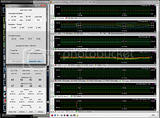The Asus P6T series is one of the few boards that has followed the original Intel design spec and will throttle the turbo from 21X to 20X when you reach either the TDP/TDC power/current limit or your CPU starts running too hot which is usually around 80C to 85C. When this first starts to happen, the multiplier will cycle rapidly between 21X and 20X hundreds of times a second. The multi will drop, power consumption and temps decrease and then the multi is allowed to go back up to 21X until this threshold is reached again. When things get more severe, the multiplier will be stuck at 20X max but you have to have a pretty significant overclock going with lots of core voltage before this will start to happen.
Most of the Gigabyte boards didn't bother enforcing this recommendation from Intel and some of the higher end Asus boards give you an option in the bios to enable or disable turbo throttling.
Asus has released a few special bios versions to disable turbo throttling if you choose to. Bios 0006 for the Asus P6T Deluxe v1 works great. No turbo throttling whatsoever no matter how hard you push it. This bios can also be cross flashed to the P6T Deluxe v2 boards with the same results. Intel has also released a similar bios for the P6T6 WS Revolution and will likely release more if users need this feature. To be honest, it's only a very tiny percentage of users that are running hard enough to actually need this feature.
The i7 Turbo program reads two high performance timers within the CPU and is the Intel recommended method to determine the multiplier. This method also works on Core 2 based CPUs. There are two timers for each thread and all you have to do is compare them once per second. If the two timers are running at the same speed then there will be no turbo boost and your CPU will be using its default multiplier which is 20 for a Core i7 920. If the core timer is running at 1,050,000 cycles per second and the reference timer is running at 1,000,000 cycles per second then the ratio is 1.05 : 1. When you multiply 1.05 times your default ratio (20) you get a total of 21.0 which shows that your turbo is fully engaged with a +1 turbo boost.
This method is very precise and it makes for a very light weight algorithm. No need to sample the CPU multiplier hundreds of times a second. All software needs to do is sample these timers once per second and then it is dead simple to compute the average multiplier for that thread during the previous 1 second interval.
I just updated i7 Turbo this evening to correctly support the new socket 1156 CPUs which have a minimum multiplier of 9.0. Download it here if you want to check it out.
http://www.fileden.com/files/2008/3/3/1794507/Turbo.zip
Edit: The Intel DX58SO is one of the few boards that can cycle the multi between 21X and 22X on an i7 920 when running a single threaded app. You only get up to a 22X multi when 1 core is active. On some boards, you can disable 3 cores in the bios which isn't very practical but if you enable C-States or C3/C6 in the bios, then when a core is not busy it can automatically enter the C3/C6 sleep state and become inactive. You can use i7 Turbo to check for this. If the multiplier on a thread is between 21 and 22 when running a single threaded app, then that's likely what's going on. Most boards dump this feature as soon as you adjust the BCLK by 1 MHz so it isn't very practical for enthusiasts. I've heard the Intel board doesn't have this limitation.
rge over on XtremeSystems was testing this out and when running a single threaded SuperPI bench, he was definitely getting more than the standard +1 Turbo boost but any BCLK overclocking killed this feature.
He locked SuperPI to the first thread and you can see that it had the highest average multiplier. The default multiplier on an i7 950 is 23.0.




